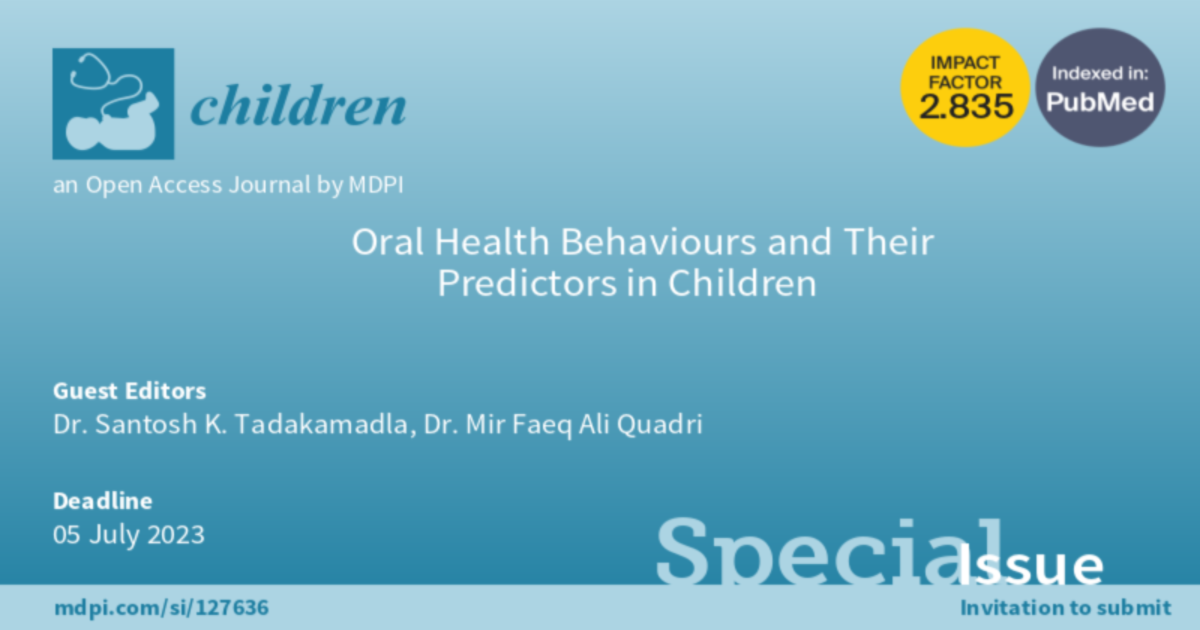Oral Health Behaviours and Their Predictors in Children
A special issue of Children (ISSN 2227-9067). This special issue belongs to the section "Pediatric Dentistry".
Deadline for manuscript submissions: closed (5 July 2023) | Viewed by 15607

Special Issue Editors
Interests: oral health; oral-systemic link; oral epidemiology; health promotion; health-related behaviour; health inequalities; health determinants; quality of life
Special Issues, Collections and Topics in MDPI journals
Interests: oral diseases; evidence-based dentistry; oral epidemiology; health disparities, quality of life; oral health care; health determinants
Special Issues, Collections and Topics in MDPI journals
Special Issue Information
Dear Colleagues,
Oral diseases are highly prevalent among children of all ages and are a major public health concern, more so in low-income countries. The most common oral disease, dental caries, is easily preventable through regular oral hygiene practices, including toothbrushing twice a day with fluoridated toothpaste and limiting sugar intake. While the management of dental disease is expensive and has a debilitating impact, prevention is simple and cost-effective. All oral health outcomes, including oral health behaviour, are determined by several population-level, family, and individual-level predictors. Reports suggest that disparities in oral health behaviours also contribute to a high burden of oral disease among underprivileged children. Therefore, evidence-based interventions targeted to improve children’s oral hygiene behaviours and reduce the effect of social, educational, and environmental barriers are warranted. Such pieces of evidence would be of help to governmental organisations and policymakers so that necessary reforms could be made.
For this Special Issue, we invite authors to submit high-quality research on the burden or pattern of oral health care practices, their determinants, and individual- or family- or community-level interventions to improve oral health care practices in children of all ages. We welcome both original articles and systematic reviews. Papers reporting on methodological aspects of research in this area will also be considered.
Dr. Santosh K. Tadakamadla
Dr. Mir Faeq Ali Quadri
Guest Editors
Manuscript Submission Information
Manuscripts should be submitted online at www.mdpi.com by registering and logging in to this website. Once you are registered, click here to go to the submission form. Manuscripts can be submitted until the deadline. All submissions that pass pre-check are peer-reviewed. Accepted papers will be published continuously in the journal (as soon as accepted) and will be listed together on the special issue website. Research articles, review articles as well as short communications are invited. For planned papers, a title and short abstract (about 100 words) can be sent to the Editorial Office for announcement on this website.
Submitted manuscripts should not have been published previously, nor be under consideration for publication elsewhere (except conference proceedings papers). All manuscripts are thoroughly refereed through a single-blind peer-review process. A guide for authors and other relevant information for submission of manuscripts is available on the Instructions for Authors page. Children is an international peer-reviewed open access monthly journal published by MDPI.
Please visit the Instructions for Authors page before submitting a manuscript. The Article Processing Charge (APC) for publication in this open access journal is 2400 CHF (Swiss Francs). Submitted papers should be well formatted and use good English. Authors may use MDPI's English editing service prior to publication or during author revisions.
Keywords
- toothbrushing
- fluorides
- dentifrices
- diet
- sugars
- oral hygiene
- behaviour
- dental caries
- oral health
- children
- family
- parents
- community
- interventions
- prevention
- systematic reviews
- research methods






